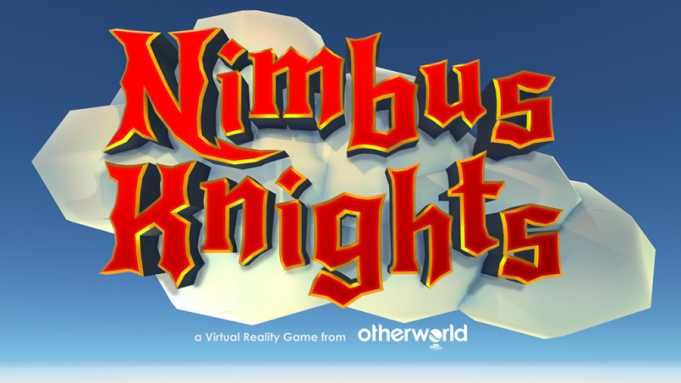The VRLA Summer Expo was held this weekend at the LA Convention Center, and it was bigger than ever. Otherworld Interactive was there, showing off their brand new HTC Vive game Nimbus Knights, a cutesy RTS where your aim is to capture floating islands by guiding Knights with your malevolent virtual hands. Guest writer Frank He had some brief hands-on time with the demo and reports back on his experience.
 Now a second year UCLA undergraduate in a neuroscience program, Frank was born in Los Angeles and then raised in Canada, spending his high school years across the border in New York. His main interest is in technologies that enable immersive experiences, and Frank’s academic path is towards better understanding the brain, how it works, and then enabling us to do something for the betterment of life through that knowledge. Besides studying, Frank makes efforts towards supporting the VR community locally and online, where he regularly participates in discussions about VR.
Now a second year UCLA undergraduate in a neuroscience program, Frank was born in Los Angeles and then raised in Canada, spending his high school years across the border in New York. His main interest is in technologies that enable immersive experiences, and Frank’s academic path is towards better understanding the brain, how it works, and then enabling us to do something for the betterment of life through that knowledge. Besides studying, Frank makes efforts towards supporting the VR community locally and online, where he regularly participates in discussions about VR.
Weaving through the packed crowd at VRLA, I made my way to Otherworld Interactive’s booth when my appointment time came up. I got there a tad early, but they got me in anyway.
Donning the Vive, which had an Oculus Rift DK2 VRcover retrofitted, I was transported to a miniature world filled with clouds and floating islands. I was passed a single Vive controller, and led through the demo.
The game would probably best described as a Lemmings (1991) RTS with a sky theme and a light-hearted, inviting art style. You could use your SteamVR controller, which had an in-game virtual platform attached to the front, to pick up your knight troops and transport them between islands. Your objective is to capture each island, by taking it over with your knights, defeating the skeleton enemies, and raising the flags. If you get far enough, you’ll be able to reveal the dark and menacing boss level, or floating island.
Despite my short time in the experience, I still got to mess around a bit. Apart from the platform, you could switch to a stick, which you might use to poke, prod, or just whack the NPCs with. I could use my platform to fling them into the air, and then quickly switch to my stick to bat them into the distance. However, the physics weren’t consistently realistic, which I suspect has to do with the NPCs having to have a method of navigation in certain situations, which may not follow real physics exactly. For example, I could not use my platform to fling troops far horizontally, as momentum was not kept.
There were some subtleties in the demo that added extra quality and immersion. When you touched things with your controller or stick, you would get a haptic vibration. Since you’re in a world of clouds, of course they would be moving with the wind, and of course when one blocks the sun, you would get accurate shadows — and you do. There are small things like that that really help to solidify and ground the world as something you, or your brain, would more associate with something real rather than something separate from the physical world. However, seeing as how I am someone who has a hard time getting presence compared to other people, these things did not greatly benefit the ease to which I could become immersed, although immersion was increased slightly. One of my friends who I met at the event also said the same thing after having tried the demo, but yet another friend very greatly lauded the haptic feedback as an effective feature.
Back to my experience — I did not walk around and use Vive’s room-scale tracking to its full potential. In fact, I could remain stationary and do everything that was required of me. This demo was not designed with huge space in mind. However, speaking with one of their developers, they may do dynamically sized levels in the future.
As an authoring tool, they made a custom function that would take a basic 2 dimensional shape, like a circle, and automatically turn it into a floating island with everything textured and ready to place in the Unity scene they were using. Work like this isn’t new to Otherworld Interactive’s Michael Murdock, the developer I had been speaking with, who has worked at Microsoft on RoomAlive, a technology that uses your real environment for dynamically mapped projection experiences. They just may have not had time to try implementing such a feature in Nimbus Knights. To be sure, the demo was put together in 3 weeks. They are aiming to release the game this holiday season to line up with the Vive’s launch.
Another thing they told me about was that they had a “networked” multiplayer version. Looking at the video feed of what the person in the demo was doing in VR, you would see that the person is represented as a cute floating cloud with eyes. This was done in consideration of multiplayer experiences. However, because they only have 1 Vive, they have not been able to test or demonstrate it. VRLA is a boon for them then, because so far I’ve seen at least 2 Vive developers talking with them about it. They’re also working on a feature where your avatar makes different facial expressions based on different situations. For example, if your troops are falling off the island or getting killed, your avatar would take on a worried expression.
We could imagine the quality of the future experience with this game, where it is very social, interactive, and polished, as this demo was quite well done considering it’s short development time of only 3 weeks.
Our thanks to Frank He for sharing his thoughts with us. You can catch up with him at his Facebook page here.






